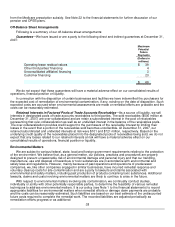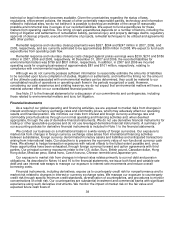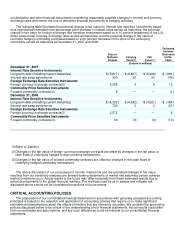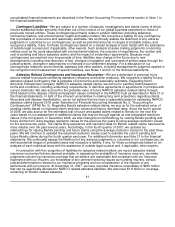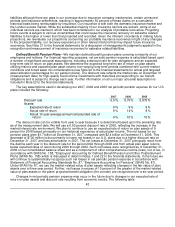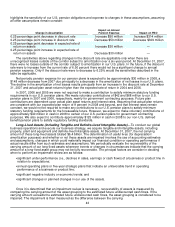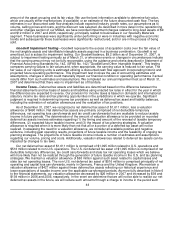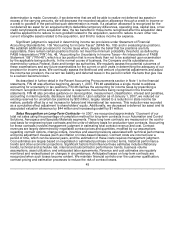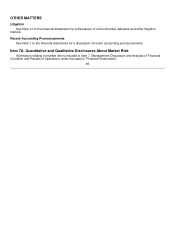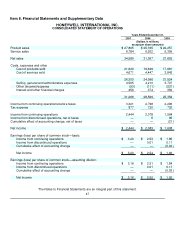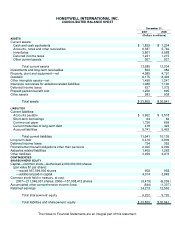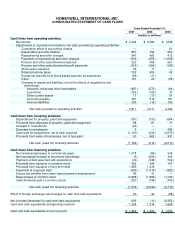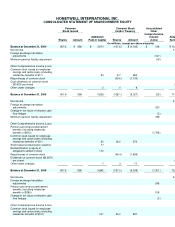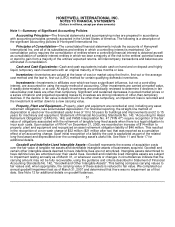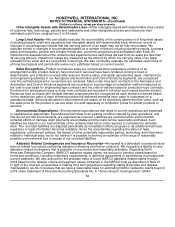Honeywell 2007 Annual Report Download - page 66
Download and view the complete annual report
Please find page 66 of the 2007 Honeywell annual report below. You can navigate through the pages in the report by either clicking on the pages listed below, or by using the keyword search tool below to find specific information within the annual report.
determination is made. Conversely, if we determine that we will be able to realize net deferred tax assets in
excess of the carrying amounts, we will decrease the recorded valuation allowance through a credit to income or
a credit to goodwill in the period that such determination is made. If a valuation allowance is recognized for the
net deferred tax asset for an acquired entity's deductible temporary differences, operating loss, capital loss, or tax
credit carryforwards at the acquisition date, the tax benefits for those items recognized after the acquisition date
shall be applied first to reduce to zero goodwill related to the acquisition, second to reduce to zero other non-
current intangible assets related to the acquisition, and third to reduce income tax expense.
Significant judgment is required in determining income tax provisions under Statement of Financial
Accounting Standards No. 109 "Accounting for Income Taxes" (SFAS No. 109) and in evaluating tax positions.
We establish additional provisions for income taxes when, despite the belief that tax positions are fully
supportable, there remain certain positions that do not meet the minimum probability threshold, as defined by
FASB Interpretation ("FIN") No. 48, "Accounting for Uncertainty in Income Taxes—An Interpretation of FASB
Statement 109" ("FIN 48"), which is a tax position that is more likely than not to be sustained upon examination
by the applicable taxing authority. In the normal course of business, the Company and its subsidiaries are
examined by various Federal, State and foreign tax authorities. We regularly assess the potential outcomes of
these examinations and any future examinations for the current or prior years in determining the adequacy of our
provision for income taxes. We continually assess the likelihood and amount of potential adjustments and adjust
the income tax provision, the current tax liability and deferred taxes in the period in which the facts that give rise
to a revision become known.
As described in further detail in the Recent Accounting Pronouncements section in Note 1 to the financial
statements, FIN 48 was effective beginning January 1, 2007. FIN 48 establishes a single model to address
accounting for uncertainty in tax positions. FIN 48 clarifies the accounting for income taxes by prescribing a
minimum recognition threshold a tax position is required to meet before being recognized in the financial
statements. FIN 48 also provides guidance on derecognition, measurement, classification, interest and penalties,
accounting in interim periods, disclosure and transition. Upon adoption as of January 1, 2007, we reduced our
existing reserves for uncertain tax positions by $33 million, largely related to a reduction in state income tax
matters, partially offset by a net increase for federal and international tax reserves. This reduction was recorded
as a cumulative effect adjustment to shareholders' equity. Additionally, we decreased a deferred tax asset and its
associated valuation allowance by $44 million and increased goodwill by $1 million.
Sales Recognition on Long-Term Contracts—In 2007, we recognized approximately 13 percent of our
total net sales using the percentage-of-completion method for long-term contracts in our Automation and Control
Solutions, Aerospace and Specialty Materials segments. These long-term contracts are measured on the cost-to-
cost basis for engineering-type contracts and the units-of-delivery basis for production-type contracts. Accounting
for these contracts involves management judgment in estimating total contract revenue and cost. Contract
revenues are largely determined by negotiated contract prices and quantities, modified by our assumptions
regarding contract options, change orders, incentive and award provisions associated with technical performance
and price adjustment clauses (such as inflation or index-based clauses). Contract costs are incurred over a
period of time, which can be several years, and the estimation of these costs requires management judgment.
Cost estimates are largely based on negotiated or estimated purchase contract terms, historical performance
trends and other economic projections. Significant factors that influence these estimates include inflationary
trends, technical and schedule risk, internal and subcontractor performance trends, business volume
assumptions, asset utilization, and anticipated labor agreements. Revenue and cost estimates are regularly
monitored and revised based on changes in circumstances. Anticipated losses on long-term contracts are
recognized when such losses become evident. We maintain financial controls over the customer qualification,
contract pricing and estimation processes to reduce the risk of contract losses.
45



